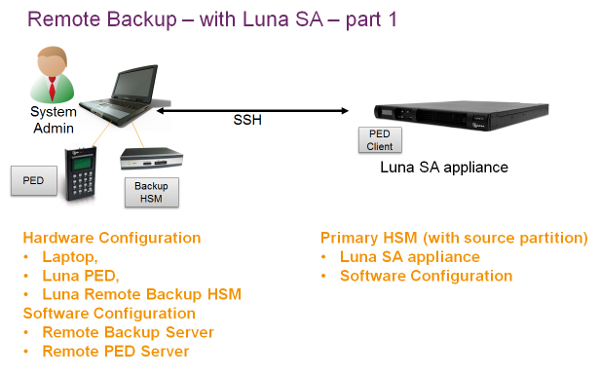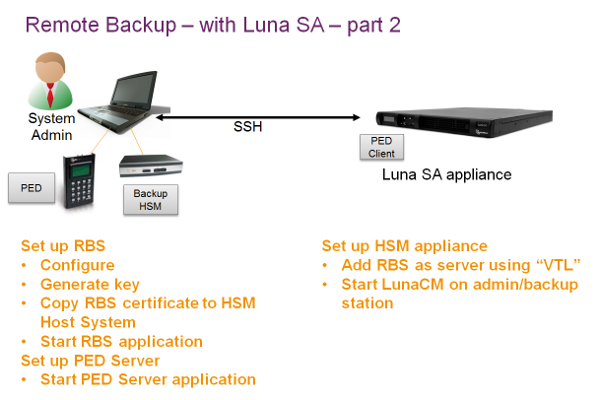Remote Backup Service
RBS (Remote Backup Service) allows you to backup and restore between a SafeNet Luna Backup HSM and a hosted primary SafeNet Luna PCIe HSM, where the two are distant from each other, while separating the backup responsibility from HSM partition ownership. That is, the person responsible for administering the Backup workstation (with attached SafeNet Luna Backup HSM) does not have Owner/User authentication (black PED key) for the primary HSM's partition.
RBS is not a standalone feature. It is a service that facilitates certain scenarios when backing-up HSM partitions or restoring onto those partitions, using a backup HSM that is distant from the primary HSM and its host or client.
RBS is run on the computer that hosts the SafeNet Luna Backup HSM, only. Running RBS also requires running pedClient on that computer, as well as on the distant primary - the paired instances of pedClient form the communications link that makes RBS possible.
Examples of the primary HSM might be:
>A SafeNet Luna PCIe HSM in its host computer (where the PCIe HSM is a local slot when viewed by LunaCM on the host computer)
>A SafeNet Luna PCIe HSM partition, seen as a "local" slot in LunaCM on a computer that is a registered client of that SafeNet Luna PCIe HSM
See Prepare RBS to Support Backup / Restore.
Sample Setup and Deployment
We will depict a sample deployment with SafeNet Luna USB HSM, the HSM that connects to a host computer via USB, and SafeNet Luna PCIe HSM, the HSM that is installed inside a host computer. Our choice is to consider the setup that the majority of customers seem to prefer:
1.A host computer with HSM residing in a secure room (server room, or other lock-up with restricted physical access)
2.An administrative workstation, often a laptop with both Remote PED and Remote Backup HSM equipment, communicating with the primary HSM via SSH or Remote Desktop Protocol sessions
The HSM in the host takes care of cryptographic operations requested by client applications residing in the host computer.
The admin computer serves the HSM administrator who performs administrative and maintenance duties on behalf of the primary HSM on the host, including authentication for login and activation via Remote PED, and Remote Backup and Restore operations to/from the attached SafeNet Luna Backup HSM.
First, a look at the described setup in everyday operation, without considering Backup and Restore.
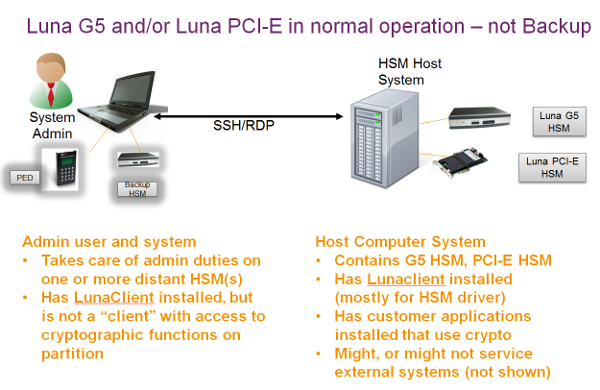
Here is the general case of Remote Backup, with the functions distributed on different computers.
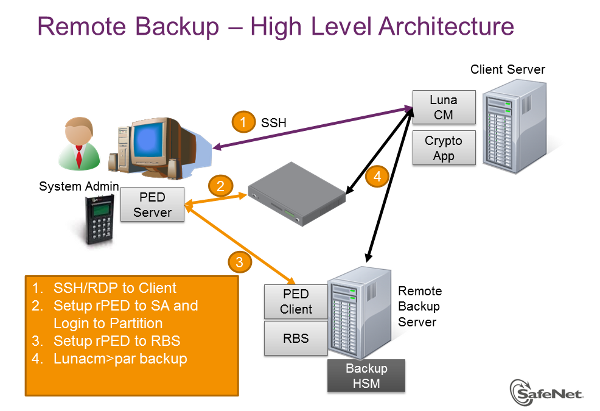
Backup is controlled via the lunacm:> command line. As a system or security administrator, you choose which computer is to run lunacm:> to accomplish the backup/restore operation. The choice of approach comes down to the familiar trade-off between convenience and security.
The lunacm:> utility resides on the HSM's host computer and views the SafeNet Luna Backup HSM as a slot at an IP address (corresponding to an administrator's workstation). The administrator uses an SSH or RDP (Remote Desktop Protocol) session to connect to the primary HSM's host computer and to work that lunacm:> instance where it resides. That is, the administrator is not using lunacm:> on his own computer to run the backup operation. The backup administrator/operator is using lunacm:> on the computer that is directly attached to the primary HSM (the one with the partition being backed up, such as SafeNet PCIe HSM), or that is a client of a network-attached HSM partition (as in SafeNet Luna Network HSM).
The lunacm:> session on the host computer views its embedded/attached HSMs as local slots. The lunacm:> session can see a distant SafeNet Luna Network HSM as a local slot if the HSM host computer has been made a client of a partition on that SafeNet Luna Network HSM (by a certificate exchange and registration.)
RBS is needed on the Remote Backup computer for this arrangement.
Other than that small difference of perspective, the Remote Backup function works identically for all primary SafeNet Luna HSMs. The drawback to this Remote Backup protocol is that one or more computers, distant from the Backup HSM must be used, as they must be clients of the SafeNet Luna HSM partitions. However, because established clients already have access to their registered partitions, the lunacm:> instance on each client computer can be employed to broker the Remote Backup operation, without exposing the partition access credentials to the operator of the Backup HSM computer. This maintains separation of roles.
The other option for an administrator wanting to back up a distant SafeNet Luna Network HSM partition is to make the computer with the Backup HSM a direct, registered client of the SafeNet Luna Network HSM. Then lunacm:> on that Backup HSM computer can see the distant SafeNet Luna Network HSM as a local slot. This is a local backup operation that does not use RBS, and does not require another computer in the process. The potential drawback is that the Backup HSM computer must have client access to every SafeNet Luna Network HSM partition that it backs up using Local Backup protocol. In some environments, this might be regarded as a security issue.
Next, a series depicting the setup and use of Remote Backup and Restore, assisted by Remote PED, where administrator, Remote PED, and Remote Backup are combined at a single laptop/workstation.

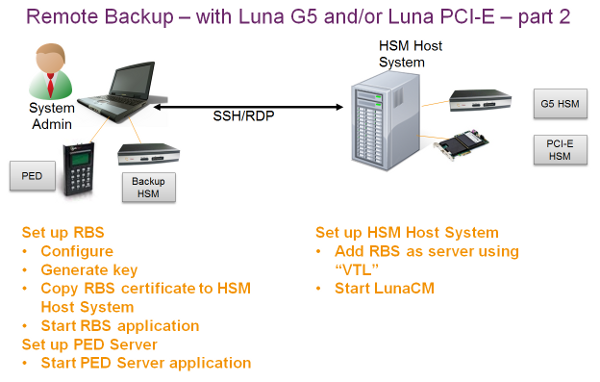
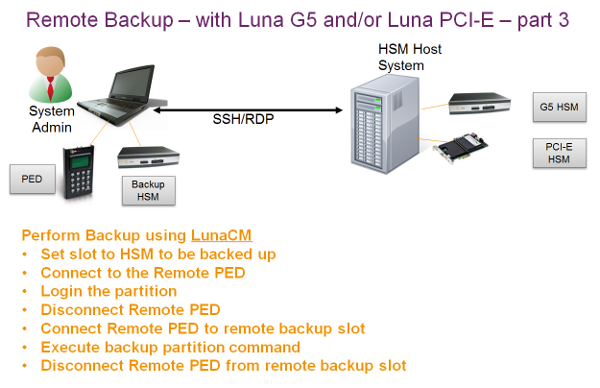
Remote Backup with Remote PED for SafeNet Luna PCIe HSM, the overview.

SafeNet Luna PCIe HSM as it would normally operate, serving clients, and being administered via lunash:> over SSH.
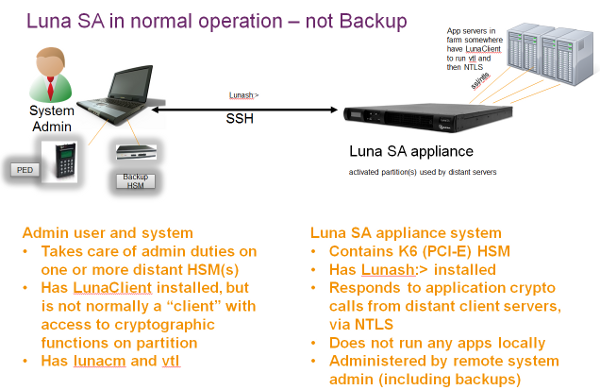
Now, a sequence summarizing Remote Backup setup and use.
